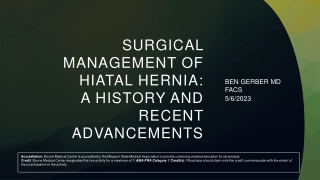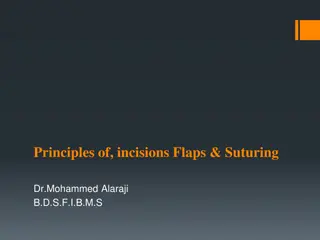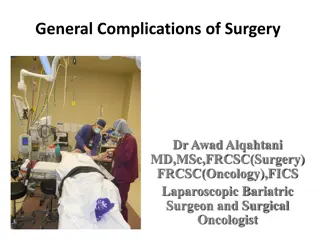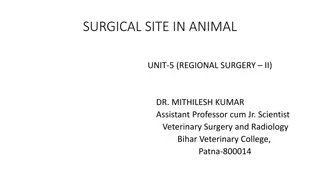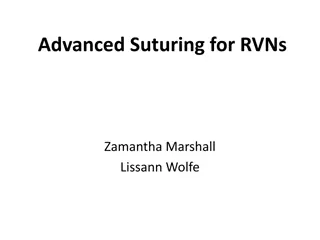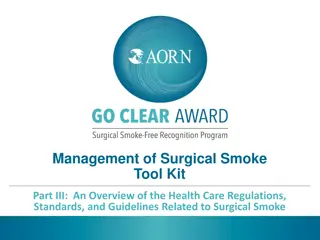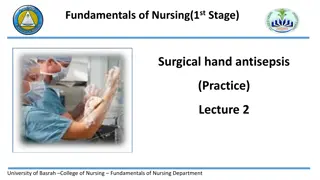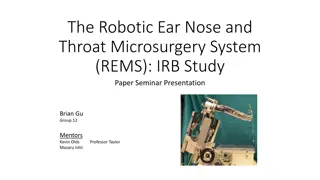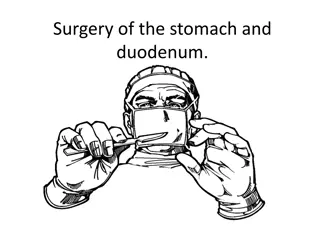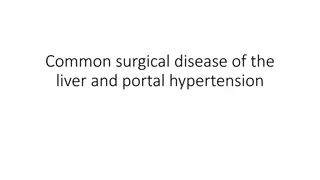Understanding Different Types of Surgical Incisions
Surgical incisions play a crucial role in accessing and treating various structures within the body. This article delves into different types of incisions, such as midline, sub-umbilical, paramedian, and pararectal. Each type has its own advantages and drawbacks in terms of access, healing, pain management, and cosmetic outcomes. Understanding these incisions is essential for surgeons and patients alike to ensure successful surgical procedures.
Download Presentation

Please find below an Image/Link to download the presentation.
The content on the website is provided AS IS for your information and personal use only. It may not be sold, licensed, or shared on other websites without obtaining consent from the author. Download presentation by click this link. If you encounter any issues during the download, it is possible that the publisher has removed the file from their server.
E N D
Presentation Transcript
Types of incisions Types of incisions assist. assist. prof Alaa Alaa Jamel MRCSI. MRCSI. CABS prof. . dr. Jamel CABS dr.
1-allow easy and rapid access to the relevant structures . 2- allow easy extension 3- should favors secure healing for the short term (dehiscence ) and long term (herniation) 4- should be relatively pain free post operatively. 5-should have a satisfactory cosmotic appearance.
Types of incisions; 1. Midline incision; Through the lina alba ,this provides good access, can be extended easily and is quick. It is relatively a vascular. Is more painful than transverse incisions. Crosses langer's lines. Poor cosmetic appearance. Narrow linea alba below umbilicus damag Some vessels cross the midline. May cause bladder injury.
. Sub umbilical incision; used for repair of par umbilical hernias and laparoscopic spot.
3. paramedian incision; 1.5 cm from midline through rectus abdominus. Was the only effective vertical incision in the days when the only available suture material was catgut. Poor cosmetic result. Can lead to infection in rectus sheath.
Other hazards include: the tendinous intersections of rectus of abdominus muscle must be dissected off; need to divide falciform ligament above the umbilicus on the right; if rectus is split more than 1 cm from medial border, the intercostals nerves are disrupted leading to denervation of medial rectus (the rectus can be retracted without splitting to avoid this).
4. Pararectal incision; now abandoned due to damage of nerves entering rectus sheath.
5. Kocher's incision; 3 cm below and parallel to the costal margin from the midline to rectus border. Good incision for cholecystectomy on the right and splenectomy on the left, but be ware superior epigastric vessels. If wound is extended laterally, too many intercostal nerves are severed. Cannot be extended caudally.
6. Double Kocher's (rooftop) incision; good access to liver and spleen. Useful for inrahepatic surgery. Used for radical pancreatic and gastric surgery and bilateral adrenalectomy. 7. Transverse muscle cutting incision; can be across all muscles beware intercostals nerves.
8. McBurney's/Gridiron incision; classic approach to appendix 'through the junction of the outer and middle third of a line from the ASIS to the umbilicus at right angles to that line'. It may be modified into a skin crease horizontal cut. The external oblique aponeurosis is cut in the line of the fibers and the internal oblique and transverses abdominus are split transversally in the line of line of the fibers. Beware-scarring is not horizontal- the iliohypogastric and ilioinguinal nerve the deep circumflex artery.
8a. Rutherford Morrison incision; the girdiron can be extended cephalic and laterally, obliquely splitting the external oblique to afford good access to the caecum, appendix and right colon.
9. Lanz; this is a lower incision than the McBurny's and closer to the ASIS. It has a better cosmetic result, but tends to divide the canal mechanism which can result in increased risk of inguinal hernia.
10. Pfannenstiel incision; most frequently used transverse incision in adults. Excellent access to female genitalia for Caesarian section and for bladder and prostate operations. Also used for bilateral hernia repair. The skin is incised in a downward convex arc into the suprapubic skin crease 2 cm above the pubis. The upper flap is raised and the rectus sheath incised 1 cm cephalic to the skin incision (not extending lateral to the rectus). The rectus is then divided longitudinally in the midline.
11. Transverse incision; particularly useful in neonates and children who do not have the subdiaphragmatic and pelvic recesses of the adult. It heals securely and cosmetically with less pain fewer respiratory problems than the longitudinal midline incision, but division of red muscle involves more blood loss and less secure closure than a longitudinal incision. It cannot be extended easily. It takes longer to make and to close. Limited access in adults to pelvic or subdiaphragmatic structure.
12. Thoraco abdominal incision; access lower thorax and upper abdomen. Used for liver and biliary surgery on the right. Used for esophageal, gastric and aortic surgery on the left.


